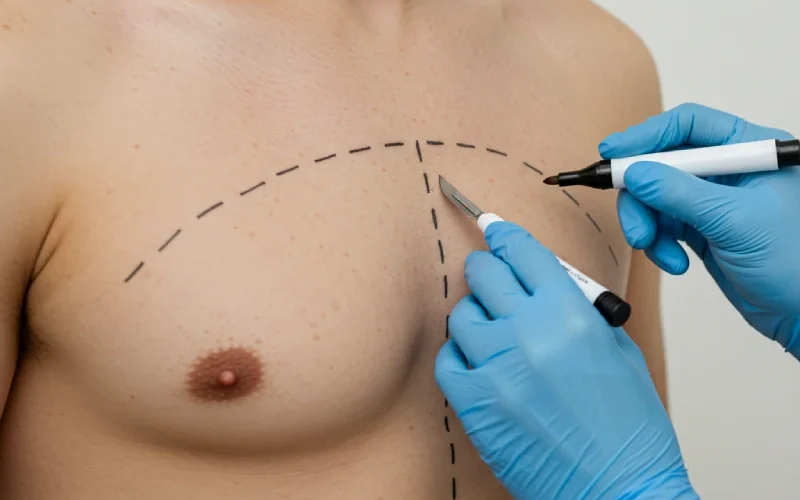Seven days after gynecomastia surgery, it’s normal to feel caught between wanting life to go back to normal and realizing your body still needs more time.
Many patients Dr. Sanket Shetty works with experience a mix of swelling, tightness, and mild soreness, and the emotional side of recovery can be just as challenging as the physical.
At this stage, your chest may still feel firm, certain movements can feel restrictive, and sleeping in the right position takes extra patience. The compression garment remains your best friend, reducing swelling and supporting healing.
Research and surgical experience show that the first two weeks are the most critical for shaping your final results.
This is why Dr. Shetty and his team provide detailed post-op care plans, ongoing check-ins, and personalised guidance, so you know exactly what’s normal and what needs attention.
Every small step now builds towards the confident, comfortable results you’re aiming for. Let’s discuss further!
Immediate Physical Changes After One Week
Swelling & Bruising on the Mend
By the end of the first week, swelling and bruising usually start to ease, bringing a sense of relief. What once looked deep purple may now appear yellow or green, fading gradually over the next few weeks. Many patients find they can reduce their use of stronger painkillers around this time.
Nerve Sensations & Chest Tightness
You may notice tingling, numb patches, or brief, sharp sensations, which are signs that nerves are beginning to recover after surgery. The chest can still feel tight or restrictive, especially during stretching or deep breaths. This sensation is normal during early healing.
Texture Changes & Skin Feel
The skin or tissue underneath may feel firm, uneven, or slightly lumpy at this stage. This firmness is caused by healing tissue and early scar development. Over the coming weeks, these areas will gradually soften and smooth out without the need for treatment.
Managing Pain and Discomfort
Medications and Doctor’s Guidance
Follow Dr. Shetty’s prescription schedule exactly, including painkillers, anti-inflammatories, or antibiotics if advised. These medications are dosed to control discomfort while preventing swelling and infection during the first stages of healing. Avoid increasing the dose on your own, as overuse can cause side effects without improving recovery.
At-Home Comfort Measures
Use a cold compress wrapped in a soft cloth for 10–15 minutes at a time to reduce tenderness and swelling, especially after light activity. Keep your upper body elevated with extra pillows while resting or sleeping.
This position improves blood circulation, supports drainage of excess fluids, and helps prevent pressure on the surgical site.
Understanding Normal Discomfort
A mild to moderate ache, chest tightness, or a sense of heaviness is common in the first week. You may also feel a pulling sensation around the incision line when reaching or twisting your torso.
These symptoms usually ease with rest and controlled movement. If pain suddenly increases, becomes sharp and persistent, or is accompanied by fever or unusual swelling, contact Dr. Shetty’s team immediately for review.
Mental and Emotional Adjustments
Understanding the Mind–Body Connection
Your body is still recalibrating after surgery that removed glandular tissue, fat, and sometimes excess skin. This triggers both physical and neurochemical changes, and temporary shifts in hormones like cortisol and serotonin can influence mood, energy, and emotional resilience.
Feeling more sensitive, impatient, or self-conscious right now is part of the body’s stress–healing cycle, not a sign that something’s wrong.
Building Confidence in the Healing Process
At one week, your chest is in its early post-op phase—swelling, mild bruising, and compression garments can hide your final result. It’s normal if the shape feels unfamiliar or uneven.
Keep in mind that skin retraction, scar tissue softening, and collagen remodeling take weeks to months.
Dr. Shetty’s recovery protocols are built from years of patient data, so following them closely gives you the best odds for an optimal long-term outcome.
Staying Grounded and Patient
Recovery timelines vary depending on skin elasticity, overall health, and the extent of surgery. Avoid comparing your progress to “one-week post-op” photos online; they may not reflect your unique healing process.
Instead, focus on measurable milestones like being able to move more freely, experiencing less tenderness, or sleeping with fewer adjustments. These small wins add up and signal that both your body and mind are adapting.
Psychological Recovery Tips
🗹 Set small, realistic goals: Aim for daily improvements rather than instant transformation.
🗹 Limit mirror checks: Assess your progress during scheduled post-op reviews instead of constant self-inspection.
🗹 Practice relaxation techniques: Slow breathing or guided meditation can help regulate post-surgery anxiety and promote better rest.
🗹 Stay connected: Share your recovery updates with trusted friends or a support group to maintain perspective.
🗹 Keep a recovery journal: Tracking pain levels, mobility, and emotions helps you see progress you might otherwise overlook.
Activity and Movement Limitations

Recommended physical rest
Now isn’t the time to lift bags or stretch arms overhead. Keep things gentle and restrict upper body movement to protect the adjusted tissues.
Gradual return of mobility
A slow walk around your home a few times a day keeps blood flowing and boosts energy. Hold off on pushing doors or lifting groceries until your surgeon clears you.
Alert signs during movement
If any motion causes a burning or tearing sensation, stop immediately. Reach out to Dr. Shetty if the discomfort feels off or doesn’t fade with rest.
Use of Compression and Dressings
Role of compression garments
Your compression vest supports the healing shape and keeps swelling low. Wear it at all times during these early weeks – it’s worth the temporary discomfort.
Proper handling of stitches
Do not remove surgical tapes or stitches unless Dr. Shetty advises it. Scratching or pulling at the healing skin could lead to scarring or infection.
Keeping the area clean and dry
Stick to sponge baths only. Keeping the dressing clean and dry is key to a smooth recovery. Change your dressings when suggested and keep clothes loose over your chest.
Nutrition and Hydration Support
Foods to Prioritise
Aim for a diet rich in lean protein (chicken, fish, eggs, legumes) to promote collagen production and tissue repair. Include vitamin C–rich fruits like oranges, kiwi, and strawberries to support wound healing, and leafy greens like spinach and kale for their iron and antioxidant content.
Zinc-rich foods such as pumpkin seeds and lentils help accelerate skin recovery. Keep hydration consistent—2 to 2.5 litres of water daily supports nutrient transport and reduces post-op swelling. Fresh coconut water or diluted fruit juices can add electrolytes without excess sugar.
Foods and Habits to Avoid
Deep-fried foods and heavily processed snacks slow down circulation and increase inflammation. Sugary drinks and alcohol can interfere with collagen formation and dehydrate tissues.
Smoking, even in small amounts, restricts oxygen delivery to healing skin, significantly delaying recovery and increasing the risk of scarring. Eliminating these for at least 4–6 weeks post-surgery can greatly improve healing outcomes.
Why a Healing-Focused Diet Matters
After gynecomastia surgery, your body enters a high-demand repair phase where it needs increased amino acids, vitamins, minerals, and hydration. Proper nutrition helps control inflammation, speeds up wound closure, and strengthens your immune system to prevent infection. Think of your diet as part of your treatment plan.
What you eat now directly influences the smoothness of your recovery and the final look of your chest.
Post-Operative Care and Hygiene
Bathing precautions
It’s safer to use a damp towel to clean around your chest instead of showering. Avoid splashing water directly near surgical areas for at least the first week.
Monitoring the surgery site
If you notice redness, weird smells, or milky discharge, call us immediately. Even a tiny opening in the wound needs review by Dr. Shetty right away.
Supporting a healing environment
Change your bedsheets regularly and wear loose, cotton clothing over the chest. Clean surroundings reduce the risk of bacteria affecting the wound site.
Medical Follow-Up and Recovery Timeline
Common milestones post week one
By this point, bruising usually fades, and swelling keeps reducing each day. Your chest starts taking on its new form, even if it’s not final yet.
Importance of upcoming check-ins
In upcoming appointments, Dr. Shetty may adjust your compression wear or stop medications. These check-ins also allow prompt action if recovery doesn’t follow the expected pattern.
Estimated total recovery duration
Most patients feel 80–90% better within a month. Final chest shape and absence of hardness usually appear after 3–6 months of care.
Get Your Consultation With Dr. Sanket Sheety
The first week following gynecomastia surgery marks a significant milestone in your recovery journey. At this point, patients often notice a reduction in the initial swelling and a gradual easing of tightness, allowing for more comfortable movement.
While it’s normal to still feel some discomfort, the body is actively healing, and you may start to see the initial contouring results.
Dr. Sanket Shetty is a leading plastic surgeon in Mumbai. He and his team provide detailed post-operative care instructions, guiding you through managing your recovery, ensuring a smooth transition toward feeling confident and at home in your new physique.

